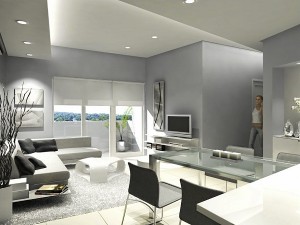
Cool tones for walls are refreshing. Off-whites and pastels in the cool tones of blue-gray tandem well with a clean and neutral black and white palette.
I visited a friend’s office the other day to see how things were turning out with her small renovation. This wasn’t a real job for me though, I merely pitched in suggestions for replacement fabrics and a new color scheme, hopefully creating a fresh and new appearance by working or reupholstery and a change of wall colors.
The rooms were looking good! With a new coat of wall paint, the rooms already appeared very different. I’d imagine that when the soft furnishings like meeting chairs, window blinds and other furniture came in, the place would surely be transformed—despite the fact that the lighting, flooring and ceilings all remained the same. Low-cost and high-impact!
Walls are the biggest surface of a room, and as such, how they are treated can have a significant impact on its overall aesthetic. While massive renovations can make dramatic changes, simple ones like modifying a wall color can make high-impact difference in the way a room feels. Here are a few tips on how to deal with a repainting job:
1 There are many shades of white and off-white. “Warm” whites (those leaning toward the yellower tones) are very popular and work excellently with color schemes with variations of reds, oranges and yellows; but there are “cool” whites too that can match your schemes, especially when they are in the color family of blues and violets.
2 View your paint color in the morning, and again in the latter part of the afternoon. Natural light has subtle tones that can affect color hues as the quality of natural light changes throughout the day: yellowish in the mornings, bluish at mid-day, yellowish again in the late afternoon and phosphorescent by dusk.
3 Artificial light does the same too. View your paint swatches at night with the lights on, or if you are doing a new construction, ask your contractor to set up the actual light you will be using. This will allow you to see a different facet of the color you chose, that of a night tone as “modified” by artificial light.
4 Pastel hues can sometimes be too strong and need to be muted to appear more pleasant to the eyes. The trick? Add a dollop of “burnt umber” tinting color. It will tame a bright pastel. Add more if you want an earthier tone. This is the secret to Scandinavian tones like sage greens and porcelain blue. While black and white can tone down bright hues, they make the colors dull and lifeless.
5 Paint colors are lighter when wet, and become darker when they dry. Therefore, never judge a paint color when it is still in the bucket. Always sample on a panel and wait until it is completely dry to see its actual color. Ideally, do two coats, as this will be the actual “thickness” of the paint, and simply doing a single coat can change the depth of color making it appear lighter than it will actually be.
6 Paint applied in a flat finish will look different from one applied in a gloss finish. The flat finish will appear to be lighter.
7 The paint texture can affect the texture of your walls: gloss and semigloss finishes will highlight imperfections while a flat or matte finish will hide it. While the latter looks better, it also catches a lot of dirt, while the former will be easier to clean. As a compromise, I like using a “sateen” finish that holds a soft sheen and yet can be easily cleaned. It also conceals small imperfections.
8 If you have traditional walls with moldings, try painting them all in one color. It will make your room feel bigger and cleaner, and it will also make your ceiling appear higher.
Contact the author through designdimensions@abi.ph or through our Asuncion Berenguer Facebook account.